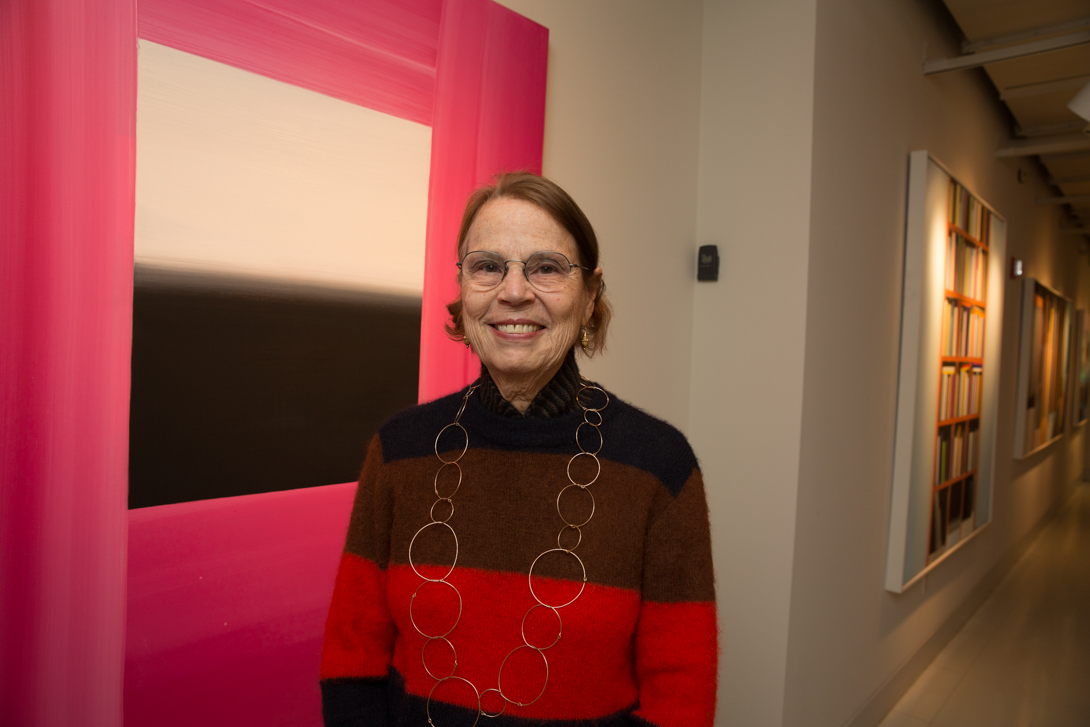Elizabeth Osborne’s paintings embrace color boldly and audaciously, unafraid of their own vibrancy. She often paints on a large canvas laid out on the floor, a technique that has resulted in wavy brushstrokes that are thick and lively.
Her brilliant palette and linear compositions often have drawn comparisons to D.C.’s own Washington Color School painters such as Kenneth Noland and Morris Louis. In fact, Ms. Osborne exhibited once with the noted group in Washington D.C.
“She actually had a show with these painters at the Washington Gallery of Modern Art. We aren’t sure who she actually showed with, but it was an early-on, and during a very important time in Washington,” Luther W. Brady Art Gallery Director Lenore Miller said.
Ms. Osborne’s work is on view in the Brady Art Gallery’s newest show, “Color Bloc: Paintings by Elizabeth Osborne.” The exhibition was derived from “Veils of Color,” another one of Ms. Osborne’s shows organized at the James A. Michener Art Museum in Doylestown, Pa. It also features new loans from the artist and from Locks Gallery in Philadelphia.
Ms. Osborne, who was a professor at the Pennsylvania Academy of the Fine Arts for nearly 50 years, visited George Washington University last week for a PAFA alumni event. Several of her former students joined her, including Lesa Chittenden Lim, who described Ms. Osborne’s influence.
“She didn’t tell you how to paint. She had a dialogue with you about where you were trying to go. And that’s a different dialogue than telling someone what to do or saying something like, ‘You know, the shape of that hand is slightly off,’” Ms. Lim said. “It elevates your game when you’re working with someone you highly respect.”
During her visit, Ms. Osborne sat down with George Washington Today and discussed more about her experiences as a teacher, the evolution of her work and how her relationship to color has changed over the years.
Q: The catalog for this show describes how your work “reveals the power of color.” To start, can you talk about your early relationship to color and how it became such a driving force in your work?
A: A show of mine will premiere in September, and it’s funny because it’s really all black, dark paintings that I did in the ‘60s. When I got out of the academy, I started with a rather subdued palette. Then I went to Paris on a Fulbright, and there, I did more of these dark paintings—the city just was gray, black and somewhat subdued to me.
Color came into my work when I started to think about things in a different way. I became interested in the West Coast painters. I suppose that I began getting away from the academy and its earthier, grayer colors. I needed to move away and cut that off. So eventually, the color became part of my oeuvre and my work. It became a more brilliant, more intense palette.
I was a figurative painter when I came out of the academy, and I eventually moved into landscapes. I used to go up to Manchester, Mass., in the summers and did a lot of plein air painting out there sitting out on the rocks. Then I’d go to the studio and use some of them for studies. I also at this time began to switch from oils to acrylics and used pouring and staining techniques, which Morris Louis, Kenneth Noland and the Washington School of Painters did.
Q: What was your connection to that group of painters?
A: It was a very significant period. The only one I ever actually met was Helen Frankenthaler. She came to Philadelphia once to critique at Penn, and I called her and asked if she would come to my studio. She said, “If I have time, I’ll bring my hard-boiled egg over for lunch.” In the end, she couldn’t come, but she was very nice—and I had looked pretty closely at her poured paintings because I was using that technique. Mine was not as loose. And, of course, I also loved Morris Louis and thought he was great.
Q: You said early on you were a figurative painter, but your work also jostles between landscapes and abstractions. When did you begin experimenting with form?
A: Landscapes lent themselves to freer, flatter shapes and flowing forms than a figure. I had been going up to Massachusetts, as I said, and I was doing a lot of little watercolors. It was just a way of studying the movement of water and the shape of rocks.
It freed me up a lot with color. I could exaggerate color, I could emphasize water, I could play with it more. With figures, I felt a little more constrained with, say, a flesh color. Some artists don’t, but I would stay closer to that realm as opposed to making a face purple or bright yellow.
I also had a student at the academy, where I taught for 50 years, who was pouring paint on the floor. I was intrigued watching her, and I said, “You know, that would be fun to try that.”
Q: It sounds like your 50 years teaching and working with students, like the one you mentioned, informed your work.
A: One thing about the academy, which I liked, was that there are serious students there. They’re in it for life. As a teacher, when I was a critic I would go around to the studios, and in a day, you would see maybe two to three really interesting and inspiring things. Sometimes it wasn’t always the case, but it was a big perk as far as I was concerned with teaching. Not only did I have to give, but I got back from students.


